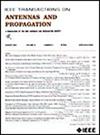Graphene-Based Current-Vector Control Method and Its Application to Continuous Polarization Reconfigurable Antennas
IF 4.6
1区 计算机科学
Q1 ENGINEERING, ELECTRICAL & ELECTRONIC
引用次数: 0
Abstract
In this article, two graphene-based current-vector control methods are first proposed. The first method utilizes the resistive property of graphene to achieve directional absorption of electromagnetic energy, thereby controlling the current amplitude. The second method exploits the differences in absorption characteristics of multiple graphene sheets in various operational states to create potential differences and generate orthogonal radiation currents, thus controlling the current direction. Then two continuous polarization reconfigurable antennas are presented using the two current-vector control methods. The polarization mode of the antenna adopting the graphene-based current amplitude control method can be tuned between left-hand circular polarization (LHCP) and linear polarization (LP) continuously with a radiation efficiency exceeding 55% at 3.2 GHz. The reconfigurable antenna utilizing the current direction control method can achieve continuously full polarization reconfigurability at 1.6 GHz. By incorporating the first proposed graphene-interlayer structure, the radiation efficiency of the antenna is enhanced by over 88% compared to the antenna loaded with graphene directly. The two graphene-based current-vector control methods proposed in this article offer new approaches for reconfigurable antenna design and expand the application scenarios of graphene.基于石墨烯的电流矢量控制方法及其在连续极化可重构天线中的应用
本文首先提出了两种基于石墨烯的电流矢量控制方法。第一种方法是利用石墨烯的电阻特性实现电磁能量的定向吸收,从而控制电流幅度。第二种方法是利用多个石墨烯片在不同工作状态下的吸收特性差异,产生电位差,产生正交辐射电流,从而控制电流方向。然后采用两种电流矢量控制方法设计了两种连续极化可重构天线。采用石墨烯电流幅值控制方法的天线极化模式可以在左旋圆极化(LHCP)和线性极化(LP)之间连续调谐,在3.2 GHz时的辐射效率超过55%。采用当前方向控制方法的可重构天线可在1.6 GHz频率下实现连续全极化可重构。通过采用第一种提出的石墨烯层间结构,天线的辐射效率比直接加载石墨烯的天线提高了88%以上。本文提出的两种基于石墨烯的电流矢量控制方法为可重构天线设计提供了新的途径,拓展了石墨烯的应用场景。
本文章由计算机程序翻译,如有差异,请以英文原文为准。
求助全文
约1分钟内获得全文
求助全文
来源期刊
CiteScore
10.40
自引率
28.10%
发文量
968
审稿时长
4.7 months
期刊介绍:
IEEE Transactions on Antennas and Propagation includes theoretical and experimental advances in antennas, including design and development, and in the propagation of electromagnetic waves, including scattering, diffraction, and interaction with continuous media; and applications pertaining to antennas and propagation, such as remote sensing, applied optics, and millimeter and submillimeter wave techniques

 求助内容:
求助内容: 应助结果提醒方式:
应助结果提醒方式:


